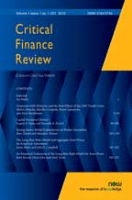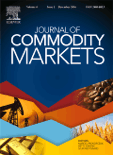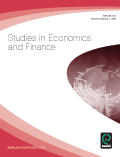
JOURNAL OF FUTURES MARKETS
Scope & Guideline
Illuminating the Path of Economic Futures
Introduction
Aims and Scopes
- Futures and Derivatives Market Analysis:
The journal publishes research that delves into the structure, behavior, and dynamics of futures and derivatives markets, including pricing mechanisms and market microstructure. - Risk Management and Hedging Strategies:
A significant focus is placed on risk management techniques and strategies employed in futures trading, exploring how various financial instruments can be utilized to hedge against market risks. - Volatility Modeling and Forecasting:
The journal emphasizes studies on volatility, including its measurement, modeling, and forecasting, which are crucial for understanding price movements in futures markets. - Interconnectedness and Spillover Effects:
Research exploring the interconnectedness of different asset classes, markets, and the spillover effects of shocks across financial systems is a key area of interest, highlighting systemic risks. - Behavioral Finance in Futures Trading:
The journal also addresses the behavioral aspects of trading in futures markets, investigating how psychological factors influence trading decisions and market outcomes. - Innovative Analytical Methods:
The use of advanced analytical techniques, including machine learning and network analysis, to improve understanding and predictive capabilities in futures markets is a distinct feature of the journal.
Trending and Emerging
- Impact of Geopolitical Risks on Markets:
There is a growing emphasis on the study of geopolitical risks and their impact on commodity futures markets, reflecting the increasing importance of global events on financial stability and pricing. - Machine Learning and AI in Trading Strategies:
The integration of machine learning and artificial intelligence into trading strategies and risk management is becoming a prominent theme, showcasing the journal's focus on technological advancements in finance. - Climate Change and Environmental Factors:
Research addressing the implications of climate change on commodity pricing and trading strategies is gaining traction, indicating a broader awareness of environmental impacts on financial markets. - Behavioral Insights and Market Dynamics:
The exploration of behavioral finance principles and their influence on market dynamics is emerging as a key area, as researchers seek to understand how psychological factors affect trading behaviors. - Dynamic and Adaptive Risk Management Techniques:
The trend towards dynamic and adaptive risk management techniques is evident, as researchers investigate more flexible strategies that can respond to real-time market changes and volatility. - Volatility of Volatility and Its Applications:
The concept of volatility of volatility is increasingly being explored, particularly in relation to its applications in pricing and risk assessment in futures markets, reflecting a more nuanced understanding of market behavior.
Declining or Waning
- Traditional Commodity Pricing Models:
There has been a noticeable decrease in publications focusing solely on traditional commodity pricing models, as researchers increasingly explore more complex and dynamic approaches that incorporate behavioral and market factors. - Static Hedging Strategies:
Research on static hedging strategies appears to be declining, with a growing preference for dynamic hedging techniques that adapt to changing market conditions and incorporate real-time data. - Local Market Analyses:
The focus on localized market analyses, which examine specific commodities or regional futures, has diminished as the journal emphasizes broader, cross-market studies that highlight global interconnectedness. - Historical Analysis of Market Trends:
Studies that primarily focus on historical trends without integrating contemporary issues or advanced methodologies have become less frequent, reflecting a shift towards more relevant and applied research. - Single-Factor Models in Risk Assessment:
The exploration of single-factor models for risk assessment has waned, with a trend towards multi-factor models that better capture the complexities of modern financial markets.
Similar Journals

Journal of Derivatives
Driving Excellence in Econometrics and Finance.Welcome to the Journal of Derivatives, a premier platform for the dissemination of cutting-edge research in the fields of Economics, Finance, and Econometrics. Published by PAGEANT MEDIA LTD, this esteemed journal has been a vital source of knowledge since its inception in 1996, with a commitment to fostering academic excellence through rigorous peer-reviewed studies. Though it presently does not operate under an open access model, the journal continues to maintain a respectable presence within its field, recognized as Q3 in both Economics and Finance as of 2023. Researchers and practitioners alike will find valuable insights and innovative methodologies, reflected in its competitive Scopus rankings, which place it among the best in its category. As the journal engages with a diverse array of topics related to derivatives and their applications, it serves as an essential resource for those seeking to deepen their understanding of financial instruments in today’s ever-evolving economic landscape. Join us in exploring the latest advancements and discussions in this critical area of study.

Journal of Investment Management
Transforming Investment Practices with Empirical Rigor.The Journal of Investment Management, with ISSN 1545-9144 and E-ISSN 1545-9152, is a prominent platform dedicated to the dissemination of cutting-edge research in the field of investment management. Published by JOURNAL INVESTMENT MANAGEMENT, this journal aims to bridge the gap between theoretical foundations and practical applications, catering to the needs of researchers, professionals, and students alike. With a focus on contemporary issues influencing investment strategies, asset allocation, risk management, and financial innovation, this journal provides valuable insights and methodologies to enhance investment decision-making processes. While currently not operating under an open-access model, the journal is accessible through various academic databases, ensuring that its critical findings reach a wide audience across the globe. Emphasizing the significance of empirical research and analytical rigor, the Journal of Investment Management plays a crucial role in shaping the future of investment practices and academic discourse in this dynamic field.

Journal of Computational Finance
Bridging theory and practice in the world of finance.Journal of Computational Finance, published by INCISIVE MEDIA, stands at the forefront of interdisciplinary research, amalgamating the realms of finance, applied mathematics, and computer science. With its ISSN 1460-1559 and E-ISSN 1755-2850, this journal provides a vital platform for scholars and practitioners alike, aiming to advance methodologies and computational techniques that enhance financial decision-making processes. Although currently categorized in the Q3 quartile across various disciplines—including Applied Mathematics, Computer Science Applications, and Finance—its commitment to quality research is unwavering, as evidenced by its curated selection of innovative studies. The journal’s scope includes computational modeling, algorithmic trading, risk management, and quantitative finance solutions. Each volume seeks to not only foster academic discourse but also bridge theoretical findings with practical applications in the financial industry. Given its convergence from 2011 to 2024, the journal continues to evolve alongside the rapidly changing financial landscape, supporting researchers, students, and professionals in navigating the complexities of computational finance.

Critical Finance Review
Fostering collaboration for groundbreaking financial theories.Critical Finance Review is a premier academic journal dedicated to advancing the field of finance through the publication of high-quality research that spans various dimensions of the discipline. Published by NOW PUBLISHERS INC, this journal has quickly established itself as a leading source of innovative finance scholarship, achieving a notable Q1 classification in the 2023 finance category. Operating under a rigorous peer-review process, the journal ensures the academic integrity and relevance of its content, which attracts contributions from both emerging and established scholars. With an ISSN of 2164-5744 and E-ISSN 2164-5760, it is accessible to a global audience, though it operates under traditional access models. The journal welcomes a diverse range of topics including, but not limited to, risk management, financial markets, and quantitative finance, making it an essential resource for researchers, professionals, and students who are keen to explore the complexities of financial systems and develop new insights in the ever-evolving landscape of finance. Based in the United States, Critical Finance Review holds a significant position within the academic community, fostering a collaborative environment that encourages innovative thinking and practical applications of financial theories.

Annals of Financial Economics
Fostering Innovation in Financial Research and PolicyAnnals of Financial Economics, published by World Scientific Publishing Co. Pte Ltd, is a premier scholarly journal catering to the fields of finance, economics, and international management. With an impressive impact factor and categorized in the Q2 quartile across multiple disciplines in the 2023 rankings, the journal holds a prominent position among its peers, evidenced by its ranking in the top 15% for Economics and Econometrics and Finance categories. The journal aims to foster high-quality, innovative research that addresses contemporary financial issues, making it a vital resource for researchers, professionals, and students alike. Although it does not operate under an open access model, it ensures that its contributions advance scientific discourse and provide valuable insights into financial theories, practices, and policies. With a historical publication span from 2005 to 2009 and again from 2011 to 2024, the Annals remains a critical platform for disseminating transformative ideas in financial economics, ensuring its relevance in a rapidly evolving scholarly landscape.

Journal of Commodity Markets
Pioneering Research in Commodity Economics and FinanceThe Journal of Commodity Markets, published by ELSEVIER, is a leading academic platform dedicated to the multifaceted field of commodity markets, encompassing various aspects of economics, finance, and econometrics. Established in 2016, this journal has rapidly gained recognition, reflected in its respectable impact factor and Scopus rankings, which place it in the Q2 category for both Economics and Finance, situating it among the top 20% of journals in these areas. With an accessible ISSN (2405-8513) and E-ISSN (2405-8505), the journal appeals to researchers, professionals, and students alike, providing a rich resource for understanding the dynamics of commodity trading, market analysis, and economic implications. Although it does not currently offer open access, its rigorous peer-review process ensures high-quality publications that contribute significantly to the discourse in commodity market studies. Housed in the Netherlands, the journal uniquely positions itself to influence and reflect on global commodity market trends up to the present year, 2024.

Asia-Pacific Financial Markets
Unveiling Insights into Regional Financial TrendsAsia-Pacific Financial Markets is a distinguished academic journal published by SPRINGER, dedicated to advancing the field of finance research in the Asia-Pacific region. With an ISSN of 1387-2834 and an E-ISSN of 1573-6946, this journal fosters scholarly discourse on contemporary financial markets, investment strategies, and economic policy implications. Situated within the Q3 category in Finance for 2023, it ranks #140 out of 317 in the Scopus database, reflecting its growing significance and impact within the financial research community, as evidenced by its 55th percentile ranking. Since its inception in 1996, the journal has served as a pivotal platform for researchers, professionals, and students alike, featuring rigorous empirical studies and theoretical frameworks that address emerging financial trends and challenges. While it operates under a subscription model, the journal's comprehensive scope and commitment to high academic standards make it an essential resource for anyone looking to deepen their understanding of finance in the dynamic Asia-Pacific landscape.

Review of Derivatives Research
Connecting Theory and Practice in Derivatives AnalysisThe Review of Derivatives Research, published by SPRINGER, stands as a pivotal platform for the dissemination of innovative research in the fields of derivatives, finance, and economics. Established in 1996, this journal provides deep insights into the theoretical and practical aspects of derivatives markets, catering to a diverse audience comprising researchers, practitioners, and academics. With an impact factor that reflects its significance in the scholarly community, it currently holds a Q2 ranking in the Economics, Econometrics and Finance (miscellaneous) category and a Q3 ranking in Finance, demonstrating its relevance and influence within these fields. Although it does not offer an open-access model, the Review of Derivatives Research remains an essential resource for those seeking to advance their understanding of complex financial instruments and market dynamics from 2002 to 2024. The journal's dedicated focus on the intricacies of derivatives paves the way for significant contributions to both academic research and practical applications in finance.

FINANCIAL ANALYSTS JOURNAL
Shaping the Landscape of Financial Decision-MakingFinancial Analysts Journal, published by Routledge Journals, Taylor & Francis Ltd, is a premier platform that disseminates cutting-edge research and practical insights in the fields of Accounting, Economics, and Finance. With an impressive Q1 ranking in three significant categories and a strong Scopus ranking, it is recognized as a vital resource for scholars, financial professionals, and students alike. The journal aims to bridge the gap between theory and practice, offering a forum for the discussion of key financial issues and innovative methodologies. As it continues to converge from 1996 to 2024, the Financial Analysts Journal remains committed to publishing high-quality research that shapes the future of financial analysis and decision-making. With no open access options, readers are encouraged to explore this influential journal to enhance their understanding and application of financial concepts.

Studies in Economics and Finance
Navigating the intricacies of finance and econometrics.Studies in Economics and Finance is a distinguished journal published by Emerald Group Publishing Ltd, based in the United Kingdom. With an ISSN of 1086-7376 and an E-ISSN of 1755-6791, this journal has been a significant contributor to the fields of economics, econometrics, and finance since its inception, with coverage ranging from 1977 to the present. Ranked in the second quartile (Q2) for 2023 in its relevant categories, it holds a reputable position within the 83rd percentile in the general economics, econometrics, and finance fields according to Scopus rankings. This journal aims to disseminate cutting-edge research that addresses key issues and emerging trends in the economic and financial landscapes, fostering dialogue among scholars, practitioners, and policymakers. Although it does not operate under an Open Access model, Studies in Economics and Finance continues to be an essential resource for advancing knowledge and providing insights that are crucial for understanding complex economic behaviors and financial systems.